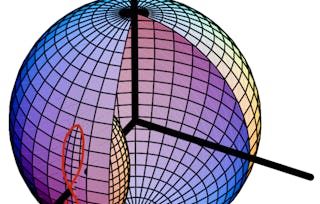As they tumble through space, objects like spacecraft move in dynamical ways. Understanding and predicting the equations that represent that motion is critical to the safety and efficacy of spacecraft mission development. Kinetics: Modeling the Motions of Spacecraft trains your skills in topics like rigid body angular momentum and kinetic energy expression shown in a coordinate frame agnostic manner, single and dual rigid body systems tumbling without the forces of external torque, how differential gravity across a rigid body is approximated to the first order to study disturbances in both the attitude and orbital motion, and how these systems change when general momentum exchange devices are introduced.

Gain next-level skills with Coursera Plus for $199 (regularly $399). Save now.

Kinetics: Studying Spacecraft Motion
This course is part of Spacecraft Dynamics and Control Specialization

Instructor: Hanspeter Schaub
11,279 already enrolled
Included with
(134 reviews)
What you'll learn
Derive the rotational equations of motion and predict and determine torque-free motion equilibria and associated stabilities
Develop equations of motion for a rigid body with multiple spinning components and derive and apply the gravity gradient torque
Apply the static stability conditions of a dual-spinner configuration and predict changes as momentum exchange devices are introduced
Derive equations of motion for systems in which various momentum exchange devices are present
Skills you'll gain
Details to know

Add to your LinkedIn profile
See how employees at top companies are mastering in-demand skills

Build your subject-matter expertise
- Learn new concepts from industry experts
- Gain a foundational understanding of a subject or tool
- Develop job-relevant skills with hands-on projects
- Earn a shareable career certificate

There are 4 modules in this course
The dynamical equations of motion are developed using classical Eulerian and Newtonian mechanics. Emphasis is placed on rigid body angular momentum and kinetic energy expression that are shown in a coordinate frame agnostic manner. The development begins with deformable shapes (continuous systems) which are then frozen into rigid objects, and the associated equations are thus simplified.
What's included
19 videos9 assignments
The motion of a single or dual rigid body system is explored when no external torques are acting on it. Large scale tumbling motions are studied through polhode plots, while analytical rate solutions are explored for axi-symmetric and general spacecraft shapes. Finally, the dual-spinner dynamical system illustrates how the associated gyroscopics can be exploited to stabilize any principal axis spin.
What's included
17 videos9 assignments
The differential gravity across a rigid body is approximated to the first order to study how it disturbs both the attitude and orbital motion. The gravity gradient relative equilibria conditions are derived, whose stability is analyzed through linearization.
What's included
7 videos3 assignments
The equations of motion of a rigid body are developed with general momentum exchange devices included. The development begins with looking at variable speed control moment gyros (VSCMG), which are then specialized to classical single-gimbal control moment devices (CMGs) and reaction wheels (RW).
What's included
7 videos4 assignments1 peer review
Earn a career certificate
Add this credential to your LinkedIn profile, resume, or CV. Share it on social media and in your performance review.
Instructor

Offered by
Explore more from Physics and Astronomy
 Status: Free Trial
Status: Free TrialUniversity of Colorado Boulder
 Status: Free Trial
Status: Free TrialUniversity of Colorado Boulder
 Status: Free Trial
Status: Free TrialUniversity of Colorado Boulder
 Status: Free Trial
Status: Free TrialUniversity of Colorado Boulder
Why people choose Coursera for their career




Learner reviews
134 reviews
- 5 stars
85.07%
- 4 stars
12.68%
- 3 stars
1.49%
- 2 stars
0%
- 1 star
0.74%
Showing 3 of 134
Reviewed on Dec 20, 2025
I was able to understand the course and content with respect to kinetics. This course was knowledgeable and elaborative. Thank you for this course!!
Reviewed on Sep 22, 2020
A good course to understand concept and practical evaluation process to useit on field.
Reviewed on May 17, 2021
It's a well taught course that would otherwise have proved much more difficult.

Open new doors with Coursera Plus
Unlimited access to 10,000+ world-class courses, hands-on projects, and job-ready certificate programs - all included in your subscription
Advance your career with an online degree
Earn a degree from world-class universities - 100% online
Join over 3,400 global companies that choose Coursera for Business
Upskill your employees to excel in the digital economy
Frequently asked questions
To access the course materials, assignments and to earn a Certificate, you will need to purchase the Certificate experience when you enroll in a course. You can try a Free Trial instead, or apply for Financial Aid. The course may offer 'Full Course, No Certificate' instead. This option lets you see all course materials, submit required assessments, and get a final grade. This also means that you will not be able to purchase a Certificate experience.
When you enroll in the course, you get access to all of the courses in the Specialization, and you earn a certificate when you complete the work. Your electronic Certificate will be added to your Accomplishments page - from there, you can print your Certificate or add it to your LinkedIn profile.
Yes. In select learning programs, you can apply for financial aid or a scholarship if you can’t afford the enrollment fee. If fin aid or scholarship is available for your learning program selection, you’ll find a link to apply on the description page.
More questions
Financial aid available,
¹ Some assignments in this course are AI-graded. For these assignments, your data will be used in accordance with Coursera's Privacy Notice.

